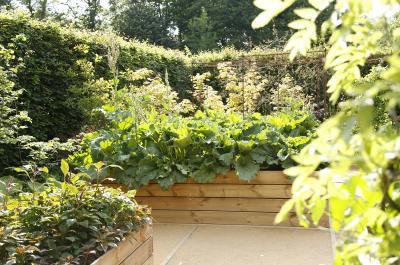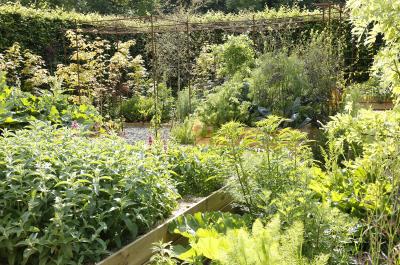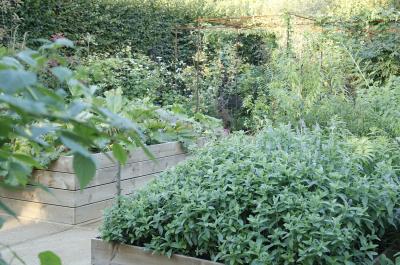14. LA RARETÉ SE MANGE-T-ELLE ?
Can rarity be eaten, or is it there for viewing only?
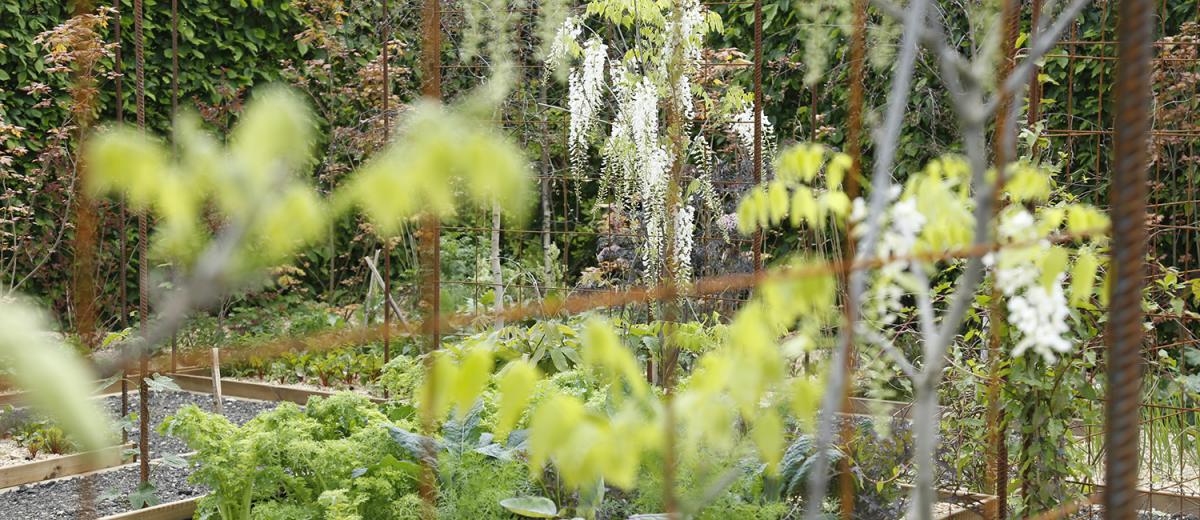
This is the challenge taken up by this garden which bids us welcome into an appetising scene. Made up entirely of edible plants, it exhibits a collection with an altogether original association of plants. This is a chance to see some forgotten varieties from a surprisingly different perspective. You might be able to recognise the root of the salsify, radish or Jerusalem artichoke, but do you know what their plants look like? Do you know how they flower?
Go through the gate and immerse yourself in a landscaped garden where the plants have then been left to grow freely. The orthogonal frame on the ground, cultivation tables and the abandoned relic of an old greenhouse, are evidence of man's hand in this garden. This is an old laboratory for studying food-producing plants - old because the vegetables have decided to escape, to get their freedom back and take over the garden. On the one hand is the production in the laboratory, showing the multiplication and improvement of species. On the other are the blossoming plants, revealing what they're capable of. The beans, peas and hops that have turned rebel stand tall as if ready to take over the structure. The dill and marrows are thriving in abundance, gradually filling the whole garden. The mustard, chicory, salsify and radish plants are becoming all entangled as they spread, proudly flaunting their flowers. The cardoons show off their bright colours, the physalis their original fruit and the artichokes their majestic figures. All of these plants parade in a collection, shaping the garden. The plants are left to grow to show us some of their characteristics that are too often ignored. Isn't that what rarity is?
DESIGNERS
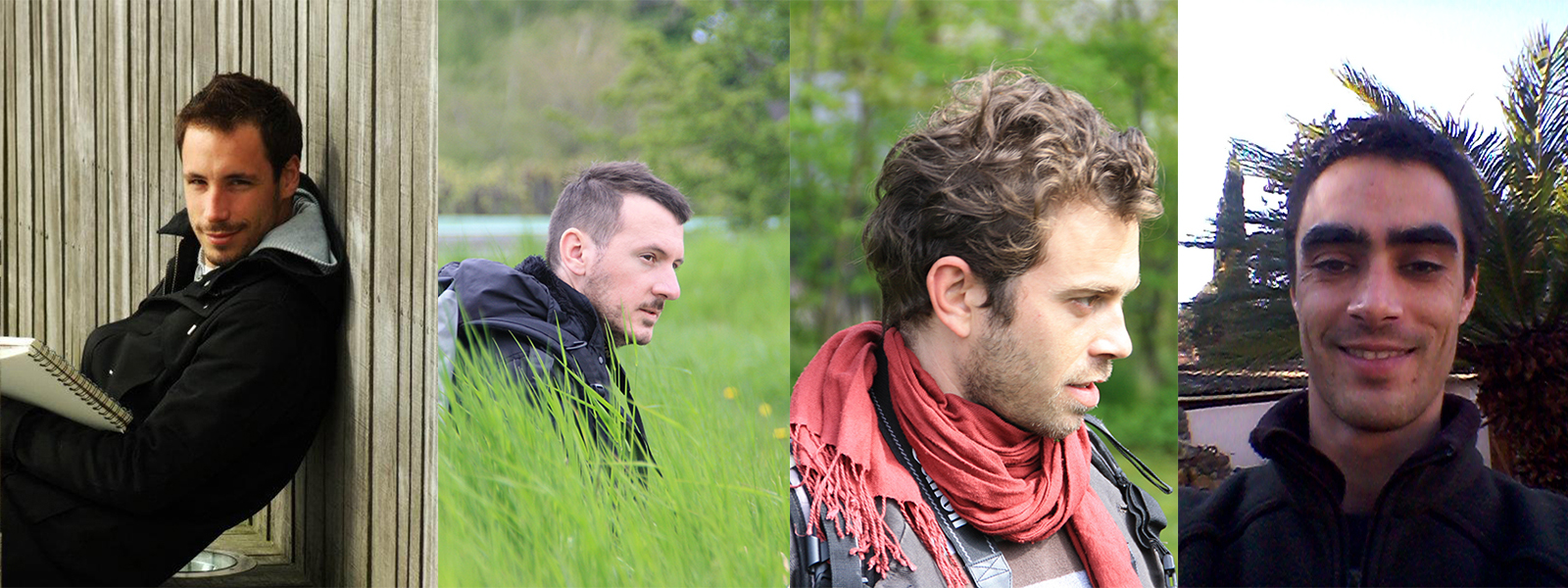
From left to right: Romain Samson, Bertrand Coudray, Jean-Charles Busson and Jérôme Mure
A native of Normandy, where he grew up surrounded by farmland and forests, Romain Samson made an early entry into the world of landscaping. When he was just 15 years old, he gave in to his fascination for the vegetable world and enrolled for a vocational training course in Evreux, leading to a Vocational Studies Certificate (BEP) in nursery gardening. He completed his initial training in 2013, graduating from Lille’s National Higher School of Architecture and Landscaping. As a freelance landscaper, he works alongside Interlieu (a landscaping agency in Lille) on urban projects paying close attention to the features that make up the landscapes concerned and shape project design. His participation in the Chaumont-sur-Loire Garden Festival capitalises on his training, enabling him to work spatially on small spaces and so call into question the very idea of what constitutes a garden.
Bertrand Coudray is a State-registered (DPLG) landscape architect. Growing up between town and country gave him an abiding taste for creation, construction and travel, which spurred him to reorientate his university studies to give free rein to his love of landscaping. Since graduating from Lille’s National Higher School of Architecture and Landscaping in 2013, his focus has been on the issues involved in revitalisation of heritage and the notion of landscape in extra-territorial contexts, including in North Africa and the Comoros Islands. Such focuses have kept him busy: he has worked on a range of projects in France and abroad and is always open to new experiences, such as here at the Chaumont-sur-Loire Garden Festival.
Jean-Charles Busson was born in Vannes in the département of Morbihan, and grew up in Grande Brière between Nantes and Saint-Nazaire. He enrolled at Nantes Higher School of Fine Arts in 1999. His initial work was essentially photographic and he produced several series of portraits of people in his entourage. His photographs, whether taken in or out of doors, are imbued with nostalgia, redolent of time come to a standstill. Then, leaving his familiar world behind him, he turned to focus on the vastness of unpopulated empty spaces evoking absence and silence. After graduating, he spent six years working for a major Parisian florist before enrolling in a landscaping course at Lille’s National Higher School of Architecture and Landscaping, obtaining his diploma in 2013. As a draughtsman, he is currently interested in spontaneous vegetation in the urban environment, in particular, those varieties of plant life that colonise pavements and cobblestones.
Jérôme Mure has been a landscaping entrepreneur since 2009, and has always been fascinated by plant life in all its forms. Born in Cannes and raised on the shores of the Mediterranean, he had no hesitation in opting for a career in landscaping, starting off by obtaining a Higher Technical Certificate in Landscape Design. He then went on to enrol in a preparatory course for acceptance at National Schools of landscaping, passing the required competitive examination and attending a year-long training course at the ENSAPL in Lille. The opportunities abounding in the South of France spurred him to make the 1000-kilometre return journey to his native region and start on a career as landscaping entrepreneur.
